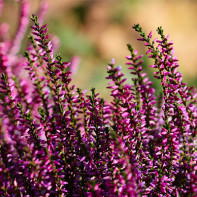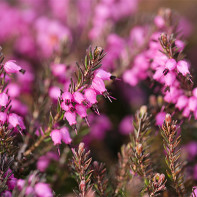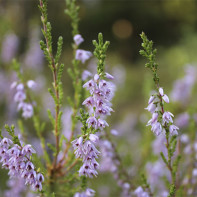Heather: medicinal properties and contraindications
Heather is a plant that is not officially considered pharmacopoeial. However, in traditional medicine, it is very successfully used to treat a wide variety of diseases.
- Chemical composition
- How it looks and where it grows
- Kinds
- Collection and storage
- What is the difference between heather and juniper
- Healing properties of heather
- For women
- For men
- During pregnancy
- For kids
- Heather in folk medicine
- Types of healing compounds
- Infusion
- Tincture
- Decoction
- Tea
- Butter
- Application in cosmetology
- What is the use of heather honey
- Contraindications
- Interesting Heather Facts
- The magical properties of heather
Chemical composition
The healing properties of heather are due to the chemical composition of its flowers and shoots. In folk medicine, sometimes the roots of the plant are used, but most often - its aerial part. The most valuable raw materials are flowers that grow on the tops of shoots. They contain:
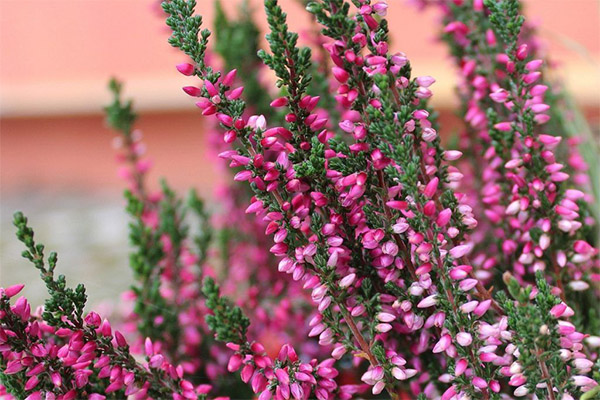
- Flavonoids (mainly quercetin and its derivatives) with anti-inflammatory and antioxidant properties.
- Phytosterols, that is, plant hormone-like substances (in this case, having the ability to replace steroid compounds).
- Organic acids, mainly chlorogenic and coffee. The first reduces the risk of cardiovascular disease, has activity against Staphylococcus aureus and Escherichia coli, has a hepatoprotective and antitumor effect. At that time, caffeic acid has anti-inflammatory as well as immunomodulatory properties. It also inhibits carcinogenesis.
- Glycosides, mainly arbutin, which is a natural antiseptic. In cosmetology, it is also used to lighten the skin, but in decoctions and infusions of heather it contains just enough to simply return a healthy complexion.
- Tannins, vitamins, minerals involved in various biochemical processes in the body.
The tops of the shoots can also be used as medicinal raw materials. They contain the already mentioned flavonoid quercetin and herbacentin, which have similar properties. They also contain tannins. They contain shoots and organic acids, but mainly citric and fumaric acid, which are inferior in properties to coffee and chlorogenic acid.
How it looks and where it grows
Heather in the wild is a relatively low creeping shrub. Its height is only 30-100 cm. The leaves of this plant are small, trihedral in shape, their width is about 2 mm, and they reach 2.5 mm in length. Petiole is absent.
Heather blooms very beautifully, its bell-shaped flowers are collected in a one-sided brush. They can be pale lilac or have a rich shade, and white heather is also found, but it is considered rare (perhaps this is why in ancient times he was credited with special magical and healing properties).
The heather fruit is a small box that contains many small seeds. However, this plant is propagated not by seeds, but by dividing the roots that appear on the side branches of the bush. When they break off, they take root and after some time become independent bushes.
For most people, heather is associated with England and Scotland. Indeed, the moorlands of the United Kingdom are very picturesque (and, by the way, are unique ecosystems). However, in the wild, heather grows in other European countries, as well as in North Africa, in some areas of Greenland, in North America and even in Asia. In Russia, under natural conditions, it is found in Siberia and the European part of the territory. But today heather is often purposefully grown in gardens.
In nature, it is rarely found in the wasteland, and more like dense thickets, pine forests and moss peatlands.
Kinds
It should be noted that from a botanical point of view, heather is the only representative of the genus Heathers. But the genus itself belongs to a fairly large family, which includes about 4 thousand shrubs, trees and even grasses.
All types of heather that are found today in gardens are specially bred varieties that differ in height, color of petals and flowering dates. For example, they include:
- Heather is decorative, which reaches a height of 50 cm. Its flowers can be purple, lilac or white. This is a stunted shrub, and it is often grown indoors - in such conditions, it blooms from autumn to January.
- Tree heather is rather a tree, although it resembles a bush. Its height can be up to 5 m. It blooms in March-April, with white inflorescences with a pleasant aroma. This is one of the oldest garden varieties, bred back in 1658.
- Heather pink is a beautiful shrub that can have a diameter of up to 50 cm. It reaches a height of no more than 90 cm. Its trunk is thin and its branches are stiff. It blooms in April-June with bell flowers collected in long brushes of saturated red or pink color. It is considered an excellent honey plant.
- Heather is graceful. His homeland is considered South Africa. This is a low (50 cm) shrub. The flowers have a goblet shape, there are a lot of them, and they are collected in an inflorescence, more like a ball. This variety does not tolerate frosts, it is often grown in the winter garden.
Other popular varieties include heather Carmen and Hamilton. The first of these varieties is distinguished by pink-purple flowers and is among the undersized plants - its height does not exceed 40 cm. Hamilton is an English variety bred in 1935. It is also considered undersized, and its main difference is the terry structure of the flowers. In total, there are more than 300 varieties of this plant.
Collection and storage
As a medicinal material, the aerial part of the plant is collected. It is believed that the most powerful healing properties of inflorescences. But usually they are cut off along with the top of the shoots, for which a pruner is used. Raw materials need to be collected during the period of active flowering of the plant, in most varieties this is August.
The raw materials must be sorted and then dried, laying out in a thin layer on a cotton cloth or on paper (but not on newspapers so that printing ink does not get on the petals). Raw materials are best dried in the open, but in the shade. An attic room is also suitable (provided that it is well ventilated). After a few days of drying, the flowers and leaves will easily shake off from the branches. They are the most valuable raw material. In the future, it should be stored in paper bags or linen bags in a dark and dry place.
Less commonly, roots are used as medicinal raw materials. But if they are needed, they are dug up at the end of October. Care must be taken not to damage the rhizome. The roots themselves are cleaned of soil, washed, then dried in the usual way.
What is the difference between heather and juniper
In fact, heather and juniper are two completely different plants. Outwardly, they are completely different, and the confusion arises due to the fact that in many regions the ancient Slavic name of juniper is still in use - heather.
Juniper is a coniferous plant. In a warm climate, it can bloom 2 times a year, then cones appear on it with a characteristic aroma and a bluish tint. The needles of the plant are dark green, the length of each needle is 5–25 mm, so that they are even longer than the leaves of heather.
Healing properties of heather
Heather has medicinal properties, many of which are confirmed by scientific research. In particular, it was found that the plant:
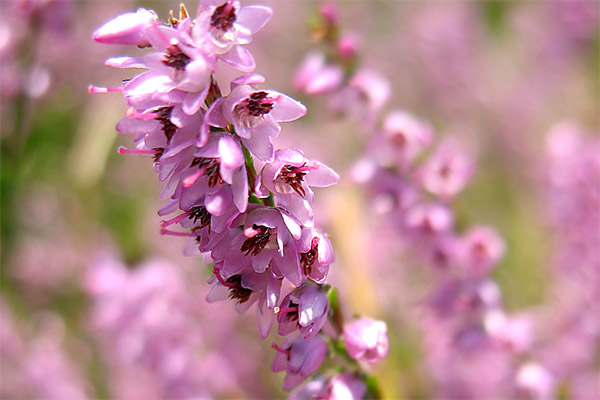
- Helps to remove excess uric acid, which is very useful for gout.
- It has anti-inflammatory and antibacterial effects, which allows you to take it with pyelonephritis and other renal diseases.
- It has the properties of a soft diuretic, which allows it to cope with puffiness.
- It has expectorant and diaphoretic properties. Due to this, decoctions and infusions of heather can be used for acute respiratory viral infections and diseases of the respiratory tract, which are accompanied by a cough.
- Improves blood coagulation.
- It has a mild sedative effect and fights against sleep disturbances.
The tannins present in the composition of this plant, as well as some other compounds, have astringent and enveloping properties. Therefore, in the pharmaceutical industry it is used for the production of various drugs, including those intended for the treatment of the digestive tract. In addition, due to the relatively high glycoside content, heather is used as a raw material for medicines that stimulate the cardiovascular system. Its extract is also used to treat inflammatory diseases of the oral cavity.
For women
For the fair sex heather is interesting in that it contains many antioxidants, including provitamin A, and anthocyanins (they give the lilac flowers their characteristic color). All of these substances help stop the premature aging process.
The anti-inflammatory properties of heather also help to use it in the treatment of certain diseases of the pelvic organs.
The phytosterols contained in the flowers make this plant an excellent remedy for menopause or painful periods (most often this raw material is brewed in such cases in the form of tea).
For men
As you know, representatives of the stronger sex are more likely to encounter a disease such as gout. It is caused by excessive production of uric acid and is accompanied by very painful pain in small joints, especially on the toes. The peculiarity of heather just lies in the fact that it suppresses the excess production of uric acid, that is, eliminates the very cause of the disease. And at the same time it has analgesic properties, which allows to improve the patient's condition.
In addition, the organic acids that make up the heather inhibit the growth of tumors, which is very important for diseases such as adenoma and prostatitis.
During pregnancy
Expectant mothers often face the problem of swelling, as well as kidney diseases caused by the fact that the growing uterus compresses all internal organs. In such cases, drinking ready-made pharmaceuticals is dangerous, as they can adversely affect the condition of the child. But heather has no contraindications, at the same time relieves inflammation and has a slight diuretic effect, which allows you to fight pyelonephritis and eliminate puffiness.
For kids
Young children are not recommended to give infusions and decoctions of heather, as well as honey, so as not to provoke the development of an allergic reaction. You can begin to get acquainted with these tools only from the moment the child is at least 3 years old. Then heather tea is given to excitable children as a mild sedative. With its help treat diseases of the respiratory tract.
Heather in folk medicine
Although official science continues research on heather and does not yet include it in the list of medicinal herbs, it has been used in folk medicine since ancient times. Including heather is used for such diseases:
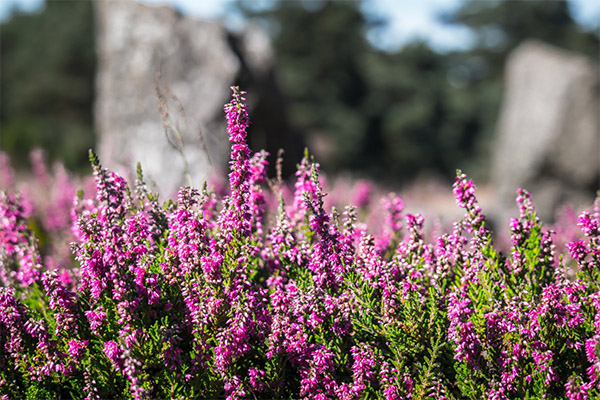
- Inflammation of the bladder and kidneys, chronic pyelonephritis. In this case, the broth is prepared as follows - 2 teaspoons of dry crushed raw materials are poured with a glass of freshly boiled water and insisted for 15 minutes in a water bath, and then left under a closed lid until it cools down. The tool is drunk little by little during the day.
- Joint pathologies that are inflammatory in nature (arthritis, rheumatism, polyarthritis). You can drink a decoction prepared according to the above recipe. But compresses are also used to treat these pathologies. For them, take 1 tbsp. a spoonful of dried flowers per 300 ml of boiling water (a glass and a half) and insist this remedy in a thermos for 2 hours.The compress is made of gauze folded in several layers, which is immersed in a warm infusion, squeezed slightly and applied to the affected joint, fixed with an elastic bandage and covered with a woolen cloth or scarf. The compress is left for 30-60 minutes. The procedure is repeated daily.
- Stomatitis, an inflammatory disease of the gums or tongue. The broth is prepared as follows - 2 tbsp. tablespoons of dried flowers pour 0.4 l of boiling water, kept in a water bath for 15 minutes and left to cool. Thus, the cooking method will be the same, but the broth will turn out to be more concentrated. With this tool, gargle and oral cavity every 2-3 hours. You can also make dental baths by simply collecting the liquid in your mouth and holding it for 3-5 minutes (then they spit it out, pick up a new portion and repeat the procedure).
- Angina, tonsillitis, other diseases of the throat. A warm broth of heather for rinsing is also used.
- Bronchial asthma and inflammation of the airways. Heather tea is prepared as follows - 1 teaspoon of leaves and flowers is brewed with a glass of boiling water and insisted for 10-15 minutes. Although it is believed that it is better to drink a cup of such tea in the evening, since it has a calming effect, do not do it immediately before bedtime (the drink has a diuretic effect). It is better to drink tea a couple of hours before bedtime.
- Colitis, diarrhea, abdominal pain associated with intestinal irritation syndrome. In such cases, heather tea is also drunk - no more than a cup per day.
- To achieve a diuretic effect, use 100 ml of heather honey, prepared according to the recipe described below. This tool is also considered effective for removing stones from the bladder and kidneys, but only if the stones are small.
- Nervous system disorders, skin diseases, arthritis and rheumatism. Heather baths are recommended. They require infusion in large quantities and, moreover, in high concentration. To prepare take half a glass of dried flower raw materials in 5 liters of hot water, which has recently boiled. Insist this tool for half an hour, then pass through a gauze filter and pour it into the bath. The duration of the water treatment should not exceed 20 minutes. It is best done in the evening, even every day, since it has no side effects.
- Skin diseases. Dry heather powder may be used for treatment. For him, they take both flowers and leaves, grinding them practically into dust. A wound is sprinkled with such a powder, which does not heal for a long time, and a sterile dressing is applied on top. Heather Powder acts as a natural antibiotic. The procedure is repeated daily until the wound heals. Also, this powder can be mixed into the composition of therapeutic ointments, which are used to heal burns.
The compresses described above are also used for allergic rashes, dermatitis and eczema. They are considered an effective remedy for lichen, burns, superficial wounds.
Heather honey (a beekeeping product, not a drink made on the basis of the plant) can act as a sedative, just take 1 teaspoon of it per day, and it is best in the evening.
In folk medicine, heather juice can also be used, which is obtained not from dry, but from fresh raw materials. It is used mainly for gargling and in the treatment of stomatitis and gum disease. At the same time, it is also taken orally - it is considered a good tool for normalizing blood sugar levels. But it can also be used as an external remedy, including for the treatment of conjunctivitis.
Types of healing compounds
Heather is used mainly in the form of water and alcohol infusions, and also as a decoction or tea (they differ in different concentrations).
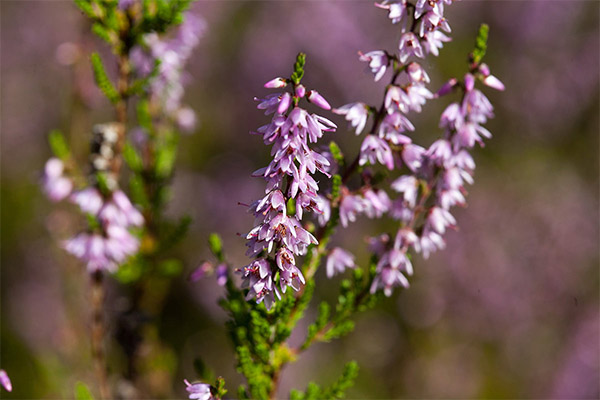
Infusion
This is a universal remedy that helps with any inflammatory diseases. Prepare it as follows - take 10 g of dried flowers and pour a glass of boiling water. The product is heated in a water bath over low heat for another half hour, then poured into a thermos for another hour, and then filtered.It can be used in the treatment of cardiovascular diseases, gastritis, and other inflammatory processes in the stomach and intestines. Drink 20 ml of the drug four times a day before each meal.
Tincture
For alcohol tinctures, the roots of the plant are more often taken. They prepare it like this - for 10 g of raw materials 50 ml of medical alcohol. The product is left for 2 weeks in a dry and dark place, periodically the container with it is removed and shaken. Ready tincture must be filtered. It is taken in the treatment of prostatitis and tuberculosis, 30-40 drops 3-4 times a day, immediately before meals, preferably diluted with a small amount of water. This tool can also be used as a restorative supplement for colds or bronchitis.
Decoction
In its classic form, it is prepared as follows - take 2 tbsp. tablespoons (20 g) of chopped dried leaves or flowers and pour a glass of boiling water. The broth is kept in a water bath for 15 minutes, but it is not brought to a boil (this is important, otherwise the medicinal substances contained in the raw materials will be destroyed). The finished product is cooled for 40–45 minutes, then passed through a filter. The dosage depends on what disease it is used for. For example, if there are kidney stones or liver disease, the total volume is divided into 3 equal portions and is drunk 2-3 times a day half an hour before meals.
Tea
Heather tea is not always used for medicinal purposes. Sometimes it is drunk just for pleasure, and then the heather in its composition goes well with other plant components, such as dried berries of wild strawberries, lingonberries, raspberries or even rose hips. But it should be remembered that the latter enhances the diuretic effect of heather, so you should not get involved in such a drink.
For medicinal purposes, heather tea is brewed in the classical way, that is, take 1 teaspoon of dried flowers in a glass of boiling water and insist for a short time, literally 10-15 minutes, and they must be filtered before use.
Butter
In this form, heather is used mainly for cosmetic purposes, as well as in the treatment of skin diseases. Take a glass jar, fill it with 2/3 of fresh or dried heather flowers and completely fill with any refined vegetable oil (you can take not only olive, but also sunflower). Insist the remedy for 15 days, periodically shaking.
Application in cosmetology
From the flowers, an extract is obtained, which is widely used in cosmetology, since it contains flavonoids, tannins, organic acids and essential oils. Thanks to this, heather has wound healing and anti-inflammatory properties, in addition, it is able to slow down the aging process. It is also proven that heather is a kind of natural photoprotector, as it can protect the skin from sunburn. And in general, it compensates for the effects of ultraviolet rays, which are often the cause of premature aging. This is about skin care.
But heather is also good for hair. It is mainly valued for its anti-seborrheic effect. After all, heather helps to normalize the production of sebum, including on the scalp, so it is very useful for oily hair, which after such a lotion looks healthy and shiny.
So, in cosmetology heather-based products are used:
- for antibacterial protection;
- eliminate skin irritation;
- toning aging skin;
- stimulation of regenerative processes;
- treatment and prevention of seborrhea;
- hair strengthening;
- as a cleansing, antiseptic and astringent in the presence of acne and other rashes.
In home cosmetology, heather can be combined with other ingredients.For example, with extracts and essential oils of lavender, wormwood, chicory, peppermint, lemon balm, they are often used together for skin care. But in combination with decoctions of nettle, hops or burdock heather will be very useful for hair care.
In home cosmetology, the plant is used as follows:
- To care for dry and aging skin, heather oil is used, prepared according to the following recipe - a 2/3 glass container is filled with flowers of the plant, then it is poured with olive, grape or almond oil and insisted for two weeks at room temperature. Oil is used for massage. They are lubricated with skin rashes, eczema, wounds and burns.
- With acne, heather infusion is used, prepared according to the recipe described above. They rub the skin instead of the tonic twice a day - morning and evening.
- On the basis of a decoction of heather lotions are made that are applied to the affected areas of the skin - for example, with eczema or the appearance of a rash.
- To combat seborrhea, heather infusion prepared as described above is rubbed into the scalp. This is done about half an hour before shampooing. With dry hair, heather oil is rubbed, but only then it must be washed off very carefully.
- To make the hair shiny and healthy, use a decoction of heather for rinsing. It is enough to do this after washing the hair 1-2 times a week.
In stores, you can buy heather hydrolate (that is, in essence - water extract), which is used to moisturize the skin and add to various cosmetics - from masks and ointments to face and body scrubs.
In addition, a decoction or infusion of heather is used to rinse the oral cavity - as a therapeutic and prophylactic against inflammatory diseases and unpleasant odors.
What is the use of heather honey
As a rule, when talking about heather honey, they mean a drink based on this plant - like the one mentioned in the ballad of Robert L. Stevenson. Making homemade heather honey is a rather labor-intensive affair. But the result is worth it, because it is considered one of the best remedies for migraine, which in its effectiveness and safety is significantly superior to non-steroidal anti-inflammatory drugs.
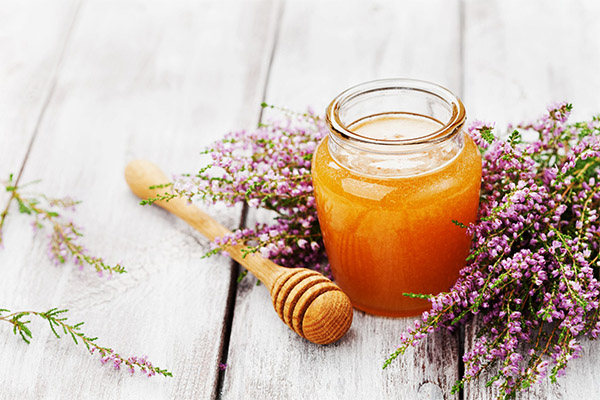
Heather honey also has a calming effect, can even be used as a light sleeping pill. It has a rejuvenating effect and provides a person with a surge of strength.
In the classic form, heather honey is prepared as follows. Take dry heather flowers - 2 tbsp. tablespoons are mixed with 1 tbsp. a spoon of Ivan-tea flowers and 2 tbsp. spoons of any flower honey. All this is poured into 0.6 liters of boiling water and insisted for two days.
The second version of the drink is prepared differently - take 3 handfuls of fresh shoots of heather with flowers, pour 2 liters of spring (or very well-purified water) and simmer for a long time until the plant material is at the bottom. When the broth cools down a little, it is filtered and flower honey is added (this is done at the final stage so that its beneficial substances are not destroyed). Honey is added to taste so that the drink is not bitter. All this is mixed, covered with a clean cloth and left in a dark place at room temperature so that the drink begins to ferment. At first it will be unclear, but in a few months it will become transparent - this means that it is ready. Drink it with caution, because he is very intoxicating.
Some heather varieties are excellent honey plants. Real heather honey, one that is a beekeeping product, is very healthy. It has a beautiful reddish tint, strong aroma and a slightly tart taste. It can also be distinguished by the presence of many small bubbles in its structure. Real heather honey is considered an excellent antiseptic.It is also used for bronchial asthma and even pneumonia. Herbalists believe that it effectively purifies the blood of toxins, and modern science has proven its antimicrobial properties (although it does not replace synthetic antibacterial agents). It has honey and restorative properties.
Contraindications
Heather is considered a safe plant, it rarely provokes an allergic reaction, but this possibility cannot be completely ruled out. Therefore, when symptoms of individual hypersensitivity appear (rash, swelling, etc.), the use of the drug will have to be stopped.
Infusions and decoctions of heather can not be used for constipation, since they exacerbate the situation. For the same reason, these drugs are contraindicated in gastritis with low acidity - they will reduce it even more.
In the presence of large calculi in the kidneys or bladder, it is not recommended to use funds based on heather, as they will not cope with the removal of stones, but can only contribute to blockage of the ducts.
Heather is not used for gastritis and ulcers, provided that these diseases are in the acute stage. In general, it should be noted that before taking any of the listed funds, you must first consult with your doctor.
Interesting Heather Facts
Although the thistle is officially considered the symbol of Scotland, in fact the majority associates this country with moorlands. This is not surprising, since the Scottish poet Robert Burns often praised this plant in his poems, and heathlands appear in the works of the Bronte sisters - for example, Jane Eyre and Wuthering Heights, creating a romantic backdrop for the dramas unfolding in these books. But the most famous was the ballad about the heather honey of Robert L. Stevenson.
For a long time, the recipe for such honey (or Scottish ale) was considered lost. In the twentieth century, it was possible to restore the technology of preparation of the drink, it turns out to be the same fragrant and with light bitterness, which was described by writers and poets of the past.
Regarding heather in Scotland, there is another legend. She says that not a single plant except heather wanted to settle on barren land in the highlands. But for this, the Lord granted this shrub not only vitality, but also a delicate aroma, and the amazing beauty of flowers. Heather is in fact almost the only plant that blooms beautifully on sandy soil, even if it contains virtually no nitrogen and phosphorus.
In Scotland, these flowers, however, were used for practical purposes. A yellow dye was prepared from them for traditional checkered tartans.
In Scotland, heather is believed to bring good luck. That is why it is often included in wedding bouquets. In addition, its branches are often carried with them for good luck.
Heather is very popular in Norway. Here it is also considered a flower of good luck, it also symbolizes youth and even immortality. In ancient times, it was believed that these flowers can stop even heavy bleeding.
Heather was used even in Slavic rites. True, they collected it long before flowering. It was necessary to cut the young shoots on Easter Eve to burn them in the oven (for good luck). Also, the branches were used as a talisman - in this case they were closed up between the bars or hung from the ceiling.
The magical properties of heather
Like any other medicinal herb, it has heather and magical properties. It has long been believed that a girl who wears a twig of this plant in her purse will happily avoid rape. If you ritually burn a little heather, coupled with fern leaves, you can cause rain, but this ability of the plant is likely to be needed when you become a shaman of some African tribe.
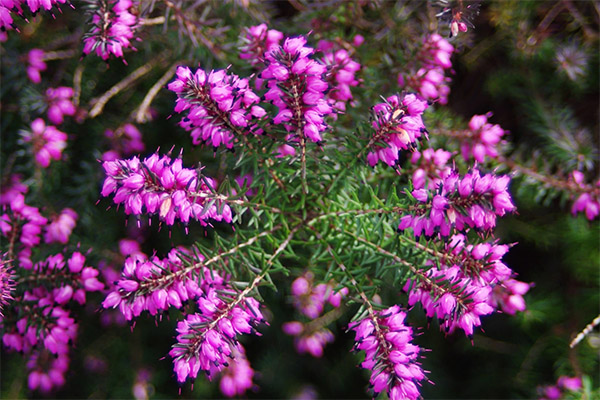
In ancient times heather was attributed to magical properties. He had to protect from evil forces. In Celtic magic rituals it was used in order to cleanse the yard and dwelling from evil spirits.
The Celts also used heather to decorate the altars and magic circles that were created on some pagan holidays - for example, on Brigitte Day, that is, February 2, in Lammas, which was celebrated on August 1, and on Halloween (for the Celts it was called Samhane) - 31 October.
In olden times, special protective properties were attributed to white heather. It was believed that he not only brings good luck, but also protects women from rape.
Ancient legends say that if a person is going to go somewhere where damage can be caused to him, then you need to put several heather branches in your pocket (only so that no one can see). The same ritual is performed when it is necessary for a person to meet luck at a meeting. Some old books say heather must be worn in a wallet so that the amount of money increases.
It was believed that if everything in the house constantly breaks, if it is impossible to ventilate (it still smells of musty), if bedbugs and fleas regularly attack, then witchcraft was sent to it. And it was possible to cope with this only with the help of heather - they fumigated the room. Moreover, it was believed that this should be done several times. For the first time, this procedure should be carried out on the first evening of the full moon, then four more times - with an interval of two evenings, that is, on the third.
This ritual looks like this. They take several white saucers, one for each room (including even a toilet, laundry room and pantry). Dried heather is laid out on each plate with a slide. Start from the front door and move counterclockwise. A plate with heather is brought into the room, set fire to it and go around with it the whole room 3 times, again counterclockwise. After this, the saucer with still smoldering heather is left in the far right corner (if you count from the door). Then the same procedure is done in the next room, etc. Early in the morning all these plates are collected, on which by that time only ashes of heather will remain. This ashes are scattered in the field near the house. In the following days, the described procedure is repeated.
It was also believed that heather could be used to cause rain. Believe it or not - everyone decides for himself. But the healing properties of heather is an indisputable fact proved by science.
«Important: all information on the site is provided exclusively in fact-finding purposes. Before applying any recommendations, consult with a profile specialist. Neither the editors nor the authors are liable for any possible harm caused materials. "


